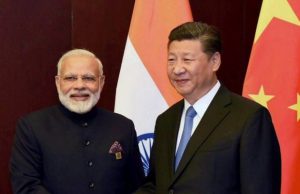The foreign ministers of India and China met on September 10 in Moscow on the sidelines of the annual Shanghai Cooperation Organization’s foreign ministers’ meeting. This highly anticipated meeting came in the backdrop of an extremely tense military standoff between the two countries in eastern Ladakh since early May this year. Writing on September 9, I had noted “… it is best not to hold out much hope for the outcome of their meeting.”
That was indeed the case. While S. Jaishankar and Wang Yi, after a meeting that lasted for more than two hours, agreed to a five-point agenda to resolve the dispute, a close reading of the joint statement that followed adds very little to the substance of India-China talks over the past few months.
Before the September 10 Moscow meeting, India and China had held several rounds of military talks at various levels, which continue. Jaishankar had spoken to Wang once before about the crisis, after the June 15 clash in the Galwan Valley. Indian Defense Minister Rajnath Singh also met with his Chinese counterpart General Wei Fenghei in Moscow last week. Finally, in their respective capacities as special representatives in the decades-long negotiations around the India-China boundary dispute, the Indian National Security Adviser Ajit Doval had also spoken to Wang on July 6. (Since last year, Doval enjoys the rank of a Cabinet Minister, like Jaishankar.)
In fact, a close side-by-side reading of the Indian foreign ministry’s statement after the July 6 conversation and yesterday’s joint statement reveals interesting differences, almost none of it indicating that India is anywhere near to achieving the outcome it seeks – restoration of status quo ante as it existed in April this year in eastern Ladakh. In fact, the joint statement – most likely to have been heavily negotiated – does not reflect key Indian positions. That said, there are modest positive signals in yesterday’s statement.
| July 6 MEA Press Release of Conversation between Doval and Wang | September 10 Joint Statement by Jaishankar and Wang | Difference |
| “frank and in-depth” | “frank and constructive” | |
| “The two Special Representatives agreed that both sides should take guidance from the consensus of the leaders that maintenance of peace and tranquillity in the India-China border areas was essential for the further development of our bilateral relations and that two sides should not allow differences to become disputes.” | “The two Ministers agreed that both sides should take guidance from the series of consensus of the leaders on developing India-China relations, including not allowing differences to become disputes.” | Linking of development of bilateral relations to the boundary issue dropped in September 10 statement. This has been a major Chinese demand throughout the crisis. |
| “…re-affirmed that both sides should strictly respect and observe the line of actual control and should not take any unilateral action to alter the status quo…” | “avoid any action that could escalate matters” | No reference to “status quo” in the September 10 statement. Restoration of status quo in eastern Ladakh remains the key sticking point for India. No reference to the Line of Actual Control either. |
| “It was also agreed that the two Special Representatives will continue their conversations to ensure full and enduring restoration of peace and tranquillity in the India-China border areas in accordance with the bilateral agreements and protocols.” | “The two Ministers agreed that both sides shall abide by all the existing agreements and protocol on China-India boundary affairs, maintain peace and tranquillity in the border areas and avoid any action that could escalate matters.” | Stronger language, in September 10 statement: “shall abide by” added to “continue conversations”
Interesting change, weakened as far as India is concerned: “ensure full and enduring restoration” changed to “maintain” |
| “The two Special Representatives agreed that the diplomatic and military officials of the two sides should continue their discussions, including under the framework of the Working Mechanism for Consultation and Coordination on India-China border affairs (WMCC), and implement the understandings reached in a timely manner to achieve the above outcomes.” | “They agreed therefore that the border troops of both sides should continue their dialogue, quickly disengage, maintain proper distance and ease tensions.”
“The two sides also agreed to continue to have dialogue and communication through the Special Representative mechanism on the India-China boundary question. They also agreed in this context that the Working Mechanism for Consultation and Coordination on India-China border affairs (WMCC), should also continue its meetings.”
|
“Quickly disengage, maintain proper distance, and ease tensions” is new and different from “in a timely manner.” It suggests an urgency on both sides. |
| “…as the situation eases, the two sides should expedite work to conclude new Confidence Building Measures to maintain and enhance peace and tranquillity in the border areas.” | New, interesting addition in the September 10 statement. Also, on paper, states the obvious: existing Confidence Building measures have failed. |
Adding to complications was a Chinese readout of the meeting that appeared late last night (Indian time). The tone of the readout was combative, as it talked about China’s “stern position” on the ongoing happenings in eastern Ladakh. It also suggested that India “does not consider the development of India-China relations to be dependent on the settlement of the boundary question,” contradicting India’s stated position. (Curiously, as I noted above, the joint statement also seems to delink the two.) Indian sources had also circulated their version of what Jaishankar communicated to Wang, including the fact that “maintenance of peace and tranquility on the border areas was essential to the forward development of ties.”
Meanwhile, the military situation on the ground remains extremely tense.

































